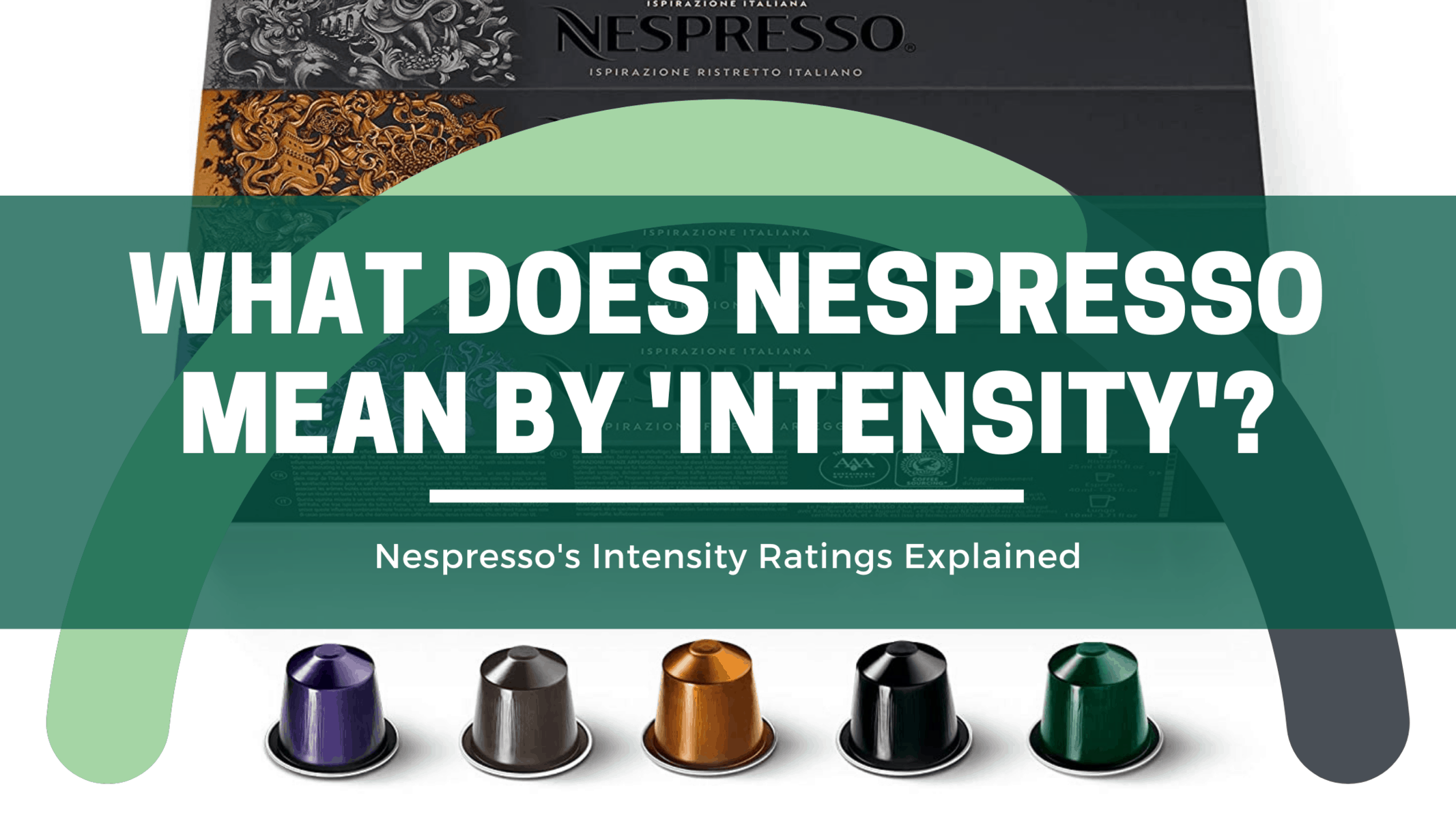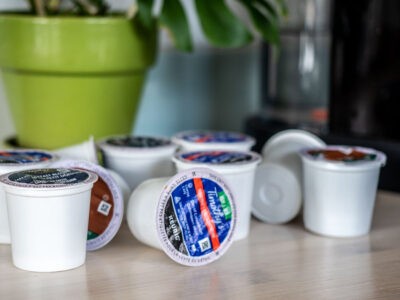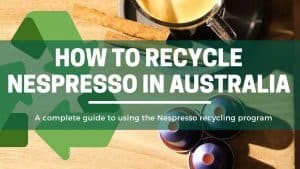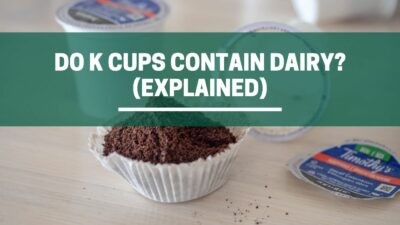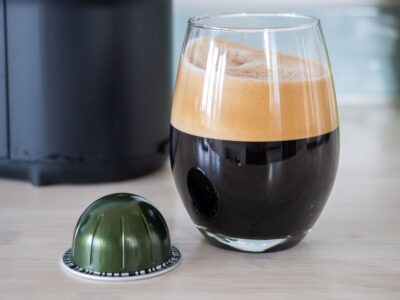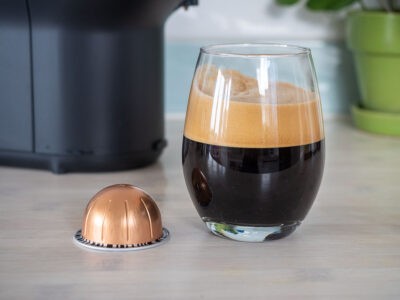Nespresso Capsules, Nespresso Guides
What Does Nespresso Mean By ‘Intensity’? Nespresso’s Intensity Ratings Explained
The term “intensity” refers to the 1-12 bar illustration on the box your pods come in. Though it might seem like it suggests how much buzz you may get from a cup, it’s actually far more complex than that.
Usually, in traditional coffee making, the intensity would mark how much coffee goes into your coffee. I.e. what’s the ratio between beans and water in a brew. Nespresso however use the term to also describe a bunch of others factors, like the amount of body, flavor, roast, and overall taste of the coffee. It does not reflect the amount of caffeine in the capsule!
In this article we’ll share how the Nespresso intensity rating is derived and what that means for your coffee.
Why Listen To Us? Well, because we KNOW coffee! In fact, we make our own coffee, coffee machine cleaners, and reusable capsules which we've sold to over 41 countries. Our team ouf experts include Tristan (an engineer), Claire (a food writer) and Richy (a barista). So, whether you're looking for a recipe or repair guide, we've got you covered 💚
Table of Contents
What Nespresso has to say about it
The company itself says that the intensity bar on their capsules has nothing to do with the amount of caffeine found in coffee. They select the rating based on the grounds to water, ratio, roast, and bitterness.
A bitter coffee with a lot of body is considered intense by Nespresso standards. Such coffees get a grade of 8 or higher on the intensity scale. The ones that are rated at 6 or lower are considered as “not intense”.
Unfortunately, the scale says nothing of the balance of those attributes. So, a marking of 8 or 9 can easily mean that you are brewing a cup that has a lot of body but very fruity in flavor, or a rather bitter brew with little coffee solids.
How to pick the right pod?
Nespresso is actually rather good at providing information about their pods. They will provide you with all the info on the roast, the type of beans, and where they are coming from.
As long as you know how to decipher those three components, you will have a good idea of what you are drinking. Then you can use the Intensity scale as an indicator of what you’ll experience.
How reliable is the indicator on the Nespresso pods?
Considering that the Nespresso pods are FDA certified, all the info at the back (or in this case, the side) of the box must be as reliable as possible. However, some are more reliable than others, especially if you take into consideration how strict EU rules are.
In short, you should reasonably expect that the “intensity scale” is a clear indicator of how much body and/or bitterness you can expect from that pod. You can also be certain that the contents of each capsule will be the almost identical as Nespresso priced themselves on strict quality control practices.
The golden cup standard
The Speciality Coffee Association state that a good cup of coffee should have 11.5 to 13.5 grams of ‘Total Dissolved Solids’ per liter of brew. Therefore, an intense cup of coffee should have closer to 13.5 grams of solids per liter (not including the sediment).
All Nespresso pods fall into the range of the golden cup standard, however (as it was mentioned above) they use their own rating system to come up with a final grade you see on the box. However, you can find a more detailed body rating (a 1-5 scale) on the official product page.
TDS is a useful measurement for professionals, but it can be very hard to contextualize for the every-day coffee drinker and impossible to measure at home. This makes it more or less useless to us ordinary consumers.
That being said, it’s the only available scientific way of defining strong coffee.
A coffee by any other name
Keep in mind that cultural heritage also has a great impact on what someone may consider being a strong or intense coffee. Some coffee drinkers may consider bitter coffee to be strong, while others are only considering the body. Regions that typically drink espresso coffee will have different tastes to parts of the world that prefer plunger, moka, or even instant coffee.
While certain standards still apply when it comes to international brands, local and independent ones may be a bit of a gamble.
Bar ratings on other Nespresso-friendly pods (third party capsules)
With numerous companies releasing pods that can work with your Nespresso machine, there is only one thing clear: there is no standardized rating system.
Each company has its own criteria. Some may seem to overlap, but that’s rarely the fact. The safest bet is to do further research into the brand or go straight in for a taste test.
Nespresso haven’t released the methodology of their rating system, so other companies attempt to create a matching rating will be purely subjective.
Our advice: use their rating system only to make comparisons within their brand of capsules. Compare apple with apples. Don’t’ expect a Nespresso capsules with and Intensity of 8 will be comparable to another manufactures capsule with the same rating.
How reliable are the ratings on these pods?
It depends on the certification. If the pods are USFDA or EFSA certified, their rating system should be quite reliable.
How to pick a pod with more caffeine?
This isn’t easy. Firstly lets touch on what factors contribute to the caffeine content.
- Roast – Look the roast info. Generally, the darker the roast, the lesser amount of caffeine. This is because the roasting process actually destroys caffeine
- Robusta vs. Arabica. These are the two distinct varieties of coffee beans, and Nespresso may use one, the other, or a blend the two within each capsule. Robust has much more caffeine than Arabica, so if you find a pod that is predominantly Robusta you’ll be in for a caffeine hit.
Most pods are of more traditional Italian/Espresso roast which has a lot less caffeine than the city roasts. Blond espresso (aka the blond roast) will give you the biggest buzz. The light city roast is the next best option if you need a bit more flavor in your cup.
Finally, we’ve written an article cataloguing the caffeine content of (almost) every Nespresso pod. You can read it here.
How to pick a pod with more flavor?
It depends on what type of flavor you are seeking, but it’s a safe bet that you will have to look up roast info as well. Darker roasts tend to be more bitter, while the lighter ones will preserve more notes that are specific to each type of coffee.
I personally like aromatic coffee that’s not too bitter as I find the bitterness detracts from the flavor. Other think a strong (Intense?) coffee is more ‘flavorful’…
So what’s evident is that flavor is highly subjective. Find what style of coffee YOU enjoy and then use the tools like Nespresso’s intensity rating to experiment and hone in on the perfect coffee for your tastes.
A Full List Of Nespresso Intensity Ratings
1. Ispirazione Italiana
| Flavor | Intensity |
|---|---|
| Kazaar | 12 |
| Napoli | 13 |
| Livanto | 6 |
| Roma | 8 |
| Arpeggio | 9 |
| Ristretto | 10 |
| Venezia | 8 |
2. World Explorations
| Rio De Janiro Espresso | 9 |
| Istanbul Espresso | 8 |
| Paris Espresso | 6 |
| Maimi Espresso | 9 |
| Cape Town Envivo | 9 |
| Shanghi | 5 |
| Stockholm Fortissio | 8 |
| Vienna Linizio | 6 |
| Tokyo Vivalto | 6 |
| Buenos Aires | 4 |
3. Master Origins
| Nicaragua | 5 |
| India | 11 |
| Indonesia | 8 |
| Colombia | 6 |
| Nicaragua La Cumplida Refinada | 5 |
| Ethiopia | 4 |
4. Barista Creations
Note: unfortunatly Nespresso don’t provide an intensity rating for their barita creation capsules.
| Filter Style Intense | – |
| Filter Style Mild | – |
| Vaniglia | – |
| Caramello | – |
| Cioccolatino | – |
| Nocciola | – |
| Freddo Intenso | – |
| Freddo Delicato | – |
| Corto | – |
| Scuro | – |
| Chiaro | – |
5. Espresso
| Capriccio | 5 |
| Cosi | 4 |
| Volluto | 4 |
6. Decaffeinato
| Volluto Decaffeinato | 4 |
| Ristretto Decaffeinato | 10 |
| Arpeggio Decaffeinato | 9 |
Conclusion
As we soon found out, the Nespresso intensity rating is a lot more complicated than it seems.
It combines factors like the roast, blend or arabica and robusta beans, the flavor profile of the bean, and the brew ratio to tell you how much of a bunch your coffee will provide you.
We also learned that it won’t tell you which pods have more or less caffeine – that’s a separate metric!.
If you enjoyed reading this article, we’d love to hear your thoughts in the comments section below.
Cheers!

